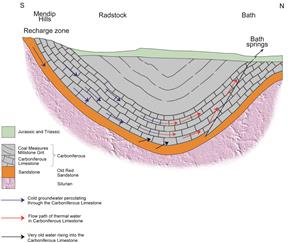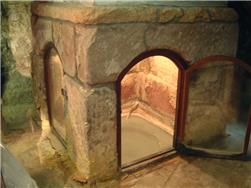UK Thermal and Mineral Springs
There are many small thermal (hot) and mineral springs in the UK. Well-known examples include those in Bath, Buxton and Harrogate. Bathing in these waters was popular amongst fashionable society in the seventeenth and eighteenth centuries, as it was considered beneficial to health. The practice continued into the nineteenth century but declined after that in the UK.
Thermal springs are a natural phenomenon which occur where hot water from great depths in the Earth rises to the surface. In the UK, groundwater normally has a temperature around 10-12oC and reflects the average annual air temperature. Shallow springs therefore have a similar temperature. As you go deeper underground the temperature increases due to heat stored in the earth, originating from when the Earth was formed and from radioactive decay of minerals. This is known as the geothermal gradient. Subsurface temperature generally increases by 26° C for every kilometre increase in depth, but this varies locally depending on the thermal conductivity of the rock. As the temperature of the earth increases with depth, so too does the temperature of the groundwater.
The source and travel path of groundwater to springs differs and as a result the nature of the water that issues from the spring is very different. The springs in Bath, Buxton and Harrogate are used here as examples to illustrate the differences.
The Bath Hot Springs

Groundwater flow through the Carboniferous aquifer
rising as springs at the city of Bath © NERC 1998
The Bath Hot Springs rise in the centre of the city of Bath in Somerset. Around 1.3 million litres of water flow from the springs every day at a temperature of around 40 °C. There is some debate about the source of the water but the generally accepted hypothesis is that rain water falling on the Mendip Hills to the south of the city infiltrates the Carboniferous Limestone and flows to the north, beneath the North Somerset coal field reaching a depth of 2.5 km from where it obtains its heat. It then rises up through fractures in the Jurassic rocks beneath the city. The chemistry of the water is dominated by calcium and sulphate with sodium and chloride also in high concentration.
There are three separate springs in Bath, the largest and most significant is the King’s Spring which rises within the Roman Baths Museum. The smaller Hetling Spring and Cross Bath Spring are located approximately 150 m to the west of the King’s Spring. The thermal spring water emerges from funnel-shaped gravel deposits under the city. Each spring is tapped at depth by a borehole, which draws water from below the shallow gravel deposits to deliver clean thermal water to the drinking fountain in the Roman Baths museum and the local spa complex.
Buxton Thermal Spring
The thermal spring at the spa town of Buxton, Derbyshire produces around a million litres of water every day at a temperature cooler than the Bath Hot Springs (of around 27 °C). It emerges at the contact between the Carboniferous Limestone and Namurian Shale in the centre of Buxton under the famous Buxton Crescent building. Again the origin of the thermal water is unclear but the depth to which the groundwater must circulate is at least 850 m. The high magnesium content of the water is thought to be due to contact with dolomitic limestone at depth. The ratio of magnesium to calcium is high, suggesting long residence times, which is confirmed by groundwater dating tests which have found the age of the water to be around 5000 years old.
Thermal water is also discharged into the nearby Pump Room, opposite the crescent building. Groundwater is directed to the Pump Room from a fissure in the rock between the main spring and the Pump Room building. The chemistry of the thermal water has been proven to be stable over time. While the water in the Pump Room is no longer used, Buxton Natural Mineral Water is bottled from the Buxton Thermal Spring.
Harrogate Mineral Springs

The Royal Pump Room in Harrogate
© Harrogate Borough Council (2010)
Almost 100 mineral springs have been recorded in Harrogate. The majority of the springs emerge either in the centre of Harrogate or further northwest in the Valley Gardens area of Harrogate. Many of the springs are connected by ancient pipework and in total are thought to discharge around half a million litres a day. The local geology comprises rocks of Carboniferous age. A series of mudstones, sandstones and limestones have been folded and faulted, controlling the distribution of the springs and forming the Harrogate Anticline. The many Harrogate mineral springs do not all originate from the same aquifer, but rather from a complex multi-aquifer system comprising Namurian sandstone and the limestone of the Harrogate Roadstone.
The source of the water is from rainfall which infiltrates the Carboniferous rocks. Parts of the recharge area are covered in drift, reducing the volume of water that can enter the groundwater system in those areas. Some of the spring waters are highly mineralised, suggesting slow-flowing, deep groundwater circulation to depths of several hundred metres. The other less mineralised springs will have shallower groundwater circulation with a shorter residence time. The spring closest to the centre of the Harrogate Anticline has the highest mineral content, rich in sulphur, and emerges in the Royal Pump Room. Tourists flock to Harrogate to bathe in the spring water and to take the water in the Royal Pump Room, believing the waters to be beneficial for skin complaints such as eczema.
Links

Print this Page